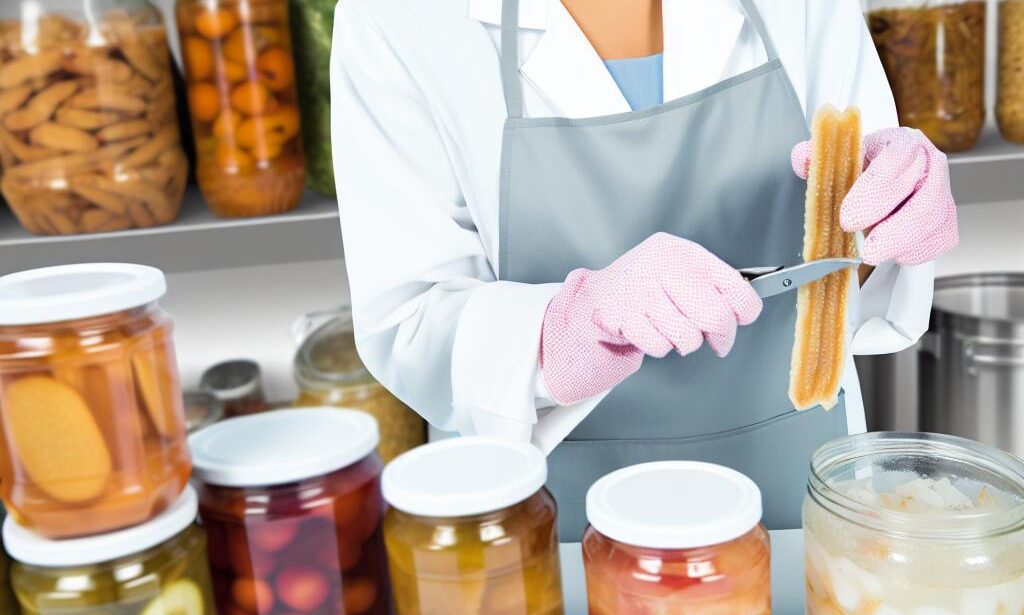Preserving food is a time-honored tradition that allows us to enjoy the bounty of the harvest year-round. Whether you’re a seasoned home cook or just starting out, learning essential techniques for preserving food safely is crucial for maintaining the quality and safety of your preserved goods. In this article, we will explore the key methods and best practices for safely preserving food at home, ensuring that your preserved foods are not only delicious, but also safe to consume.
Table of Contents
- <a href="#canning-a-time-tested-method-for-preserving-fruits-and-vegetables”>Canning: A Time-Tested Method for Preserving Fruits and Vegetables
- <a href="#dehydrating-maximizing-shelf-life-while-retaining-nutrients”>Dehydrating: Maximizing Shelf Life While Retaining Nutrients
- Freezing: Tips for Properly Storing Meats, Dairy, and Produce
- Pickling: A Versatile Technique for Preserving a Variety of Foods
- Fermenting: Harnessing the Power of Good Bacteria for Long-Term Preservation
- Q&A
- In Summary

Canning: A Time-Tested Method for Preserving Fruits and Vegetables
When it comes to preserving fruits and vegetables, canning is a tried and true method that has been used for generations. By using the right techniques, you can safely store your favorite produce for months to come. Here are some essential tips for preserving food through canning:
- Use the right equipment: Invest in quality canning jars, lids, and a large pot for boiling water. Make sure to inspect your equipment for any cracks or defects before use.
- Follow proper sanitation: Before canning, thoroughly clean and sterilize your jars, lids, and utensils to prevent any contamination.
- Choose the best produce: Select fresh, ripe fruits and vegetables for canning. Avoid using overripe or damaged produce, as it can affect the quality of the final product.
By following these essential techniques, you can ensure that your canned fruits and vegetables are safely preserved and ready to enjoy whenever you need them.

Dehydrating: Maximizing Shelf Life While Retaining Nutrients
When it comes to preserving food, dehydrating is a popular method that maximizes shelf life while retaining nutrients. By removing moisture from food, dehydrating helps prevent the growth of bacteria, yeast, and mold, which can cause food to spoil. Additionally, dehydrating food helps to retain important nutrients, making it a great option for preserving fruits, vegetables, and even meats.
There are several essential techniques for dehydrating food safely and effectively. These include:
- Proper preparation: Before dehydrating, it’s important to properly prepare the food by washing, peeling, and slicing it into uniform pieces.
- Even drying: Ensuring that the food is evenly spread out on the dehydrator trays helps to promote consistent drying and prevent any areas from being under or over-dried.
- Monitoring temperature: Different foods require different drying temperatures, so it’s important to monitor the temperature of the dehydrator to ensure that the food is drying at the appropriate heat level.
| Food Item | Drying Time |
|---|---|
| Apples | 6-12 hours |
| Tomatoes | 8-12 hours |
| Beef Jerky | 4-6 hours |

Freezing: Tips for Properly Storing Meats, Dairy, and Produce
When it comes to preserving food safely, proper freezing techniques are essential for maintaining the quality and safety of meats, dairy, and produce. Here are some tips for properly storing these items in the freezer:
- Meats: To prevent freezer burn and maintain freshness, wrap meats tightly in plastic wrap or aluminum foil before placing them in a resealable freezer bag. Label the package with the date and type of meat to easily identify it later.
- Dairy: For dairy products like cheese and butter, it’s important to store them in airtight containers or freezer bags to prevent absorption of odors and maintain their texture. Be sure to leave some room for expansion as dairy products may expand when frozen.
- Produce: When freezing fruits and vegetables, blanching them before freezing can help preserve their color, flavor, and nutrients. Once blanched, spread the produce in a single layer on a baking sheet and freeze before transferring to a freezer bag or container.
By following these proper storage techniques, you can ensure that your frozen meats, dairy, and produce remain safe to eat and maintain their quality for an extended period of time.

Pickling: A Versatile Technique for Preserving a Variety of Foods
One of the most versatile techniques for preserving a variety of foods is pickling. This method not only extends the shelf life of fruits and vegetables but also enhances their flavor. Pickling is a simple and effective way to ensure that you have access to your favorite foods all year round.
When it comes to pickling, there are several essential techniques to keep in mind to ensure that your food is preserved safely. These techniques include using the right combination of ingredients, proper sterilization of jars, and following the correct pickling process. By mastering these techniques, you can enjoy the benefits of pickled foods without any concerns about safety or quality.
Some essential techniques for pickling include:
- Choosing the right type of vinegar for pickling
- Using the correct ratio of salt to water for brine
- Ensuring that jars and lids are properly sterilized before use
- Following the recommended processing times for pickling different types of foods

Fermenting: Harnessing the Power of Good Bacteria for Long-Term Preservation
Fermenting food is an age-old technique that harnesses the power of good bacteria to preserve food for long-term storage. This process not only extends the shelf life of food but also enhances its nutritional value. By fermenting food, you can create delicious and healthy options that will last for months.
Here are some essential techniques for safely preserving food through fermentation:
- Salt brine fermentation: This method involves submerging vegetables in a saltwater solution to create an environment that is conducive to the growth of beneficial bacteria.
- Lacto-fermentation: This process involves using lactobacillus bacteria to ferment vegetables, creating a tangy and flavorful end product.
- Kombucha fermentation: Kombucha is a fermented tea that is made by adding a culture of bacteria and yeast to sweetened tea, resulting in a fizzy and probiotic-rich beverage.
| Technique | Description |
|---|---|
| Salt brine fermentation | Submerging vegetables in a saltwater solution to create an environment conducive to the growth of beneficial bacteria. |
| Lacto-fermentation | Using lactobacillus bacteria to ferment vegetables, creating a tangy and flavorful end product. |
| Kombucha fermentation | Adding a culture of bacteria and yeast to sweetened tea, resulting in a fizzy and probiotic-rich beverage. |
Q&A
Q: Why is it important to preserve food safely?
A: Preserving food safely helps to prevent foodborne illnesses and spoilage, and extends the shelf life of perishable items.
Q: What are some essential techniques for preserving food safely?
A: Some essential techniques for preserving food safely include canning, freezing, drying, pickling, and fermenting.
Q: How does canning work as a preservation method?
A: Canning involves sealing food in jars and heating them to destroy microorganisms, preventing spoilage.
Q: What are the key considerations when freezing food for preservation?
A: When freezing food for preservation, it’s important to properly package and label items, and to maintain a consistent temperature in the freezer.
Q: How does drying food help to preserve it?
A: Drying food removes moisture, which inhibits the growth of bacteria and mold, and helps to extend the shelf life of the food.
Q: What is the process of pickling and how does it preserve food?
A: Pickling involves immersing food in a solution of vinegar, salt, and spices, which creates an acidic environment that inhibits the growth of bacteria and preserves the food.
Q: How does fermenting work as a preservation method?
A: Fermenting involves the natural breakdown of sugars in food by bacteria and yeast, which creates an acidic environment that preserves the food and enhances its flavor.
Q: What are some best practices for ensuring food safety when preserving food at home?
A: Some best practices for ensuring food safety when preserving food at home include following tested recipes, using proper equipment, and practicing good hygiene and sanitation.
In Summary
In conclusion, preserving food safely is essential for extending the shelf life of perishable items and reducing food waste. By utilizing techniques such as canning, freezing, and pickling, individuals can ensure that their food remains safe to consume for an extended period of time. It is important to follow proper guidelines and procedures to prevent the growth of harmful bacteria and maintain the quality of the preserved food. By incorporating these essential techniques into your food preservation routine, you can enjoy the benefits of having a well-stocked pantry and reducing your environmental impact. Remember to always prioritize safety and follow recommended practices when preserving food at home.

